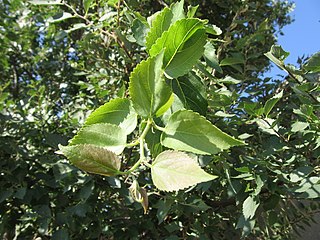
The International Union for Conservation of Nature (IUCN) Red List of Threatened Species, also known as the IUCN Red List or Red Data Book, founded in 1964, is an inventory of the global conservation status and extinction risk of biological species. A series of Regional Red Lists are produced by countries and organizations, which assess the risk of extinction to species within a political management unit.

The macaques constitute a genus (Macaca) of gregarious Old World monkeys of the subfamily Cercopithecinae. The 23 species of macaques inhabit ranges throughout Asia, North Africa, and Europe. Macaques are principally frugivorous, although their diet also includes seeds, leaves, flowers, and tree bark. Some species such as the long-tailed macaque will supplement their diets with small amounts of meat from shellfish, insects, and small mammals. On average, a southern pig-tailed macaque in Malaysia eats about 70 large rats each year. All macaque social groups are arranged around dominant matriarchs.

The conservation status of a group of organisms indicates whether the group still exists and how likely the group is to become extinct in the near future. Many factors are taken into account when assessing conservation status: not simply the number of individuals remaining, but the overall increase or decrease in the population over time, breeding success rates, and known threats. Various systems of conservation status are in use at international, multi-country, national and local levels, as well as for consumer use such as sustainable seafood advisory lists and certification. The two international systems are by the International Union for Conservation of Nature (IUCN) and The Convention on International Trade in Endangered Species of Wild Fauna and Flora (CITES).

Nepenthes glabrata is a tropical pitcher plant endemic to Sulawesi. The species grows in open, high forest at elevations of 1600 to 2100 m. It produces dainty, colourful pitchers reaching only a few centimetres in height. These traps are red speckled on a yellowish background, giving them a "hand painted" appearance.

A species that is extinct in the wild (EW) is one that has been categorized by the International Union for Conservation of Nature as known only by living members kept in captivity or as a naturalized population outside its historic range due to massive habitat loss.
Basselinia glabrata is a species of palm tree endemic to New Caledonia. It was formerly placed in the genus Alloschmidia.

Pritchardia glabrata is a species of palm tree. It is endemic to the island of Maui in Hawaii. Pritchardia glabrata is Endemic of Maui, Hawaii islands, USA. It grows at around 500-550 metres A.S.L. It grows on steep slopes between 300 and 900 metres above sea level on the Hawaiian Islands of Maui and Lanai, which are slightly drier.This is one of the small Pritchardia, with a slender trunk rarely reaching five meters in length, but otherwise similar to P. remote and P. waialealeana, with which it shares the same sort of simple trunk.

Biomphalaria salinarum is a species of air-breathing freshwater snail, an aquatic pulmonate gastropod mollusk in the family Planorbidae, the ram's horn snails.
Aglaia glabrata is a species of plant in the family Meliaceae. Aglaia glabrata is native to Brunei, Indonesia, and Malaysia.
Pearcea glabrata is a species of plant in the family Gesneriaceae. It is endemic to Ecuador. Its natural habitat is subtropical or tropical moist montane forests.
Robynsia is a monotypic genus of flowering plants in the family Rubiaceae. It was described by John Hutchinson and was named after his friend and colleague Walter Robyns. The genus contains only one species, Robynsia glabrata, which is found in Ghana, Ivory Coast and Nigeria. The species is morphologically similar to the genus Cuviera but differs by having long, slender corolla tubes.

Samyda is a genus of plants in family Salicaceae. There are 11 species, chiefly shrubs of the West Indies.

Samyda villosa is a species of plant in the Salicaceae family. It is endemic to Jamaica.

Nepenthes nigra is a tropical pitcher plant known from a number of mountains across Central Sulawesi, where it grows at elevations of 1,500–2,700 m (4,900–8,900 ft) above sea level. The specific epithet nigra refers to the dark colouration of the pitchers and stem. The species is closely related to N. hamata and N. tentaculata.
Calliandra haematomma is a species of flowering plants of the genus Calliandra in the family Fabaceae. Calliandra pilosa is a synonym of C. haematomma var. glabrata.

A vulnerable species is a species which has been categorized by the International Union for Conservation of Nature as being threatened with extinction unless the circumstances that are threatening its survival and reproduction improve.

Celtis glabrata is a deciduous tree in the genus Celtis, native to parts of eastern Europe and western Asia. Its Turkish common name is dahum.

Endangered species, as classified by the International Union for Conservation of Nature (IUCN), are species which have been categorized as very likely to become extinct in their known native ranges in the near future. On the IUCN Red List, endangered is the second-most severe conservation status for wild populations in the IUCN's schema after critically endangered. In 2012, the IUCN Red List featured 3,079 animal and 2,655 plant species as endangered worldwide. The figures for 1998 were 1,102 and 1,197 respectively.
Vatica glabrata is a tree in the family Dipterocarpaceae, native to Borneo. The specific epithet means "smooth-skinned".











